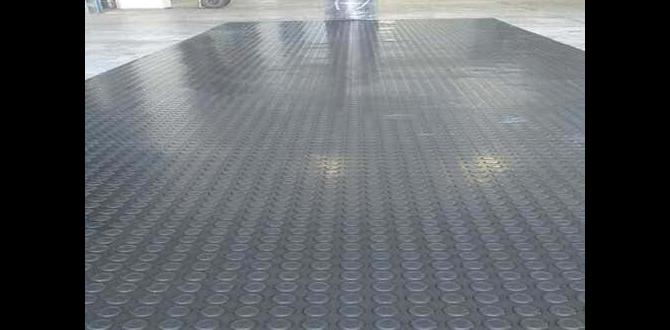Looking to speed up your compost pile? These genius compost accelerator recipes turn kitchen scraps and yard waste into rich soil super-fast! Easy, DIY methods mean less waiting and more happy plants in your garden, whether you’re growing indoors or out.
Have you ever started a compost pile, brimming with eco-friendly intentions, only to find it sitting there, seemingly doing nothing? It can be a bit disheartening, right? You’re adding your kitchen scraps and garden trimmings, but the whole process feels agonizingly slow. Don’t worry; this is a super common challenge for beginner gardeners! The good news is that nature often just needs a little nudge. We’re going to explore some brilliant and simple compost accelerator recipes that will help your compost break down much faster. Get ready to see your compost transform from a pile of potential into garden gold!
What Exactly is a Compost Accelerator?
Think of a compost accelerator as a super-boost for your composting journey. When we compost, we’re relying on tiny organisms – bacteria, fungi, and other microbes – to do the hard work of breaking down organic materials into nutrient-rich humus. These helpers need the right conditions to thrive, including the right balance of nitrogen and carbon, plenty of air, and adequate moisture. A compost accelerator is simply something you add to your compost bin or pile that helps create these ideal conditions, encouraging those beneficial microbes to get to work faster and more efficiently.
Essentially, it’s a way to kickstart the decomposition process. This means you’ll have usable compost ready for your garden beds, planters, or houseplants sooner, rather than later. Whether you’re an indoor gardener nurturing delicate herbs on a sunny windowsill or an outdoor enthusiast dreaming of a bountiful vegetable patch, faster compost means healthier plants and a more sustainable garden!
Why Are Compost Accelerators So Helpful?
Using compost accelerators offers a bounty of benefits for gardeners of all levels. They’re not just about speed; they contribute to a healthier, more consistent composting process.
- Speed Up Decomposition: This is the primary benefit! Accelerators introduce or encourage the microorganisms that break down organic matter, significantly reducing the time it takes to get finished compost.
- Reduce Odors: A well-managed compost pile with the right balance of elements, often facilitated by accelerators, is less likely to produce foul smells. Faster decomposition means less material sitting around in an anaerobic (oxygen-deprived) state, which is often the cause of bad odors.
- Improve Compost Quality: By promoting a more uniform and active decomposition process, accelerators can lead to a more consistent and nutrient-rich finished compost product. This means healthier soil for your plants.
- Kill Pathogens and Weed Seeds: A hot compost pile, which accelerators help achieve, can reach temperatures high enough to kill off most harmful pathogens and viable weed seeds. This is crucial for creating safe compost for your garden.
- Boost Microbial Activity: Accelerators often introduce a diverse range of beneficial microbes or provide them with the nutrients they need to multiply rapidly, creating a more robust composting ecosystem.
- Economical and Sustainable: Many effective compost accelerators are made from readily available, natural, or repurposed materials, making them an eco-friendly and budget-conscious choice for any gardener.
Understanding the “Greens” and “Browns”
Before diving into accelerator recipes, it’s essential to understand the fundamental building blocks of good compost: “greens” and “browns.” This balance is key, and accelerators often work by helping to harmonize these elements or by providing that missing piece to get the decomposition party started.
Greens (Nitrogen-Rich Materials): These are typically moist, nitrogen-rich items that provide the protein and energy for the microbes. They tend to break down quickly.
- Fruit and vegetable scraps
- Coffee grounds and tea bags
- Grass clippings (in thin layers to avoid matting)
- Plant trimmings (fresh, non-woody)
- Manure (from herbivores like chickens, cows, horses, rabbits)
Browns (Carbon-Rich Materials): These are usually dry, carbon-rich materials that provide bulk and allow air to circulate. They break down more slowly.
- Dry leaves
- Straw and hay
- Shredded newspaper or cardboard (avoid glossy paper)
- Wood chips or sawdust (in moderation)
- Twigs and small branches
A good compost recipe often aims for a ratio of about 2 parts browns to 1 part greens by volume. Too much green can lead to a slimy, smelly pile, while too much brown can make decomposition very slow. Accelerators can sometimes help adjust this balance or provide the conditions needed for existing materials to break down effectively.
DIY Compost Accelerator Recipes: Genius Garden Hacks
No need to buy expensive commercial accelerators! You can whip up effective compost boosters right at home using everyday items. Here are some tried-and-true recipes:
1. The “Yeast & Sugar” Powerhouse
This is a classic for a reason! Yeast and sugar work together to feed and multiply the beneficial bacteria that drive decomposition. Sugar provides a quick energy source for the yeast, and the yeast, in turn, release enzymes and nutrients that kickstart microbial action.
Ingredients:
- 1 packet (about 2.25 teaspoons) active dry yeast
- 1 tablespoon sugar (any kind works – granulated, brown, or honey)
- 1 quart (approx. 1 liter) warm water
Instructions:
- In a jar or container, mix the warm water and sugar. Stir until the sugar is fully dissolved.
- Sprinkle the yeast over the sugary water.
- Give it a gentle stir.
- Let the mixture sit for about 10-15 minutes. You should see it start to foam and bubble – that’s the yeast becoming active!
- Pour this mixture directly onto your compost pile, focusing on drier areas.
- Use this accelerator recipe once every 1-2 weeks as needed.
Why it Works:
This recipe directly introduces a concentrated dose of active microorganisms and their food source (sugar). The warmth of the water also helps activate them, and the yeast’s natural enzymes aid in breaking down complex organic compounds. It’s like giving your compost a probiotic shot!
2. The “Comfrey & Manure” Garden Cocktail
Plants like comfrey are incredibly rich in nitrogen and minerals, and manure is a powerhouse of beneficial microbes and nutrients. Combining them creates a potent, natural accelerator.
Ingredients:
- Fresh comfrey leaves (the more, the better)
- A shovel or two of fresh manure (from herbivores like chickens, rabbits, cows, or horses – avoid cat or dog feces)
- Optional: A handful of garden soil
Instructions:
- Chop up the fresh comfrey leaves. It’s easier if they’ve wilted slightly, but fresh is fine too.
- In a bucket or wheelbarrow, mix the chopped comfrey with the fresh manure.
- If you have it, add a handful of healthy garden soil. This introduces a diverse range of native microbes to your compost.
- Mix everything well.
- Add this mixture to your compost pile, ideally distributing it throughout the layers.
- Repeat every few weeks, especially when adding new “brown” materials.
Why it Works:
Comfrey leaves are packed with nitrogen, which greens up the compost and fuels rapid microbial growth. Manure, especially fresh from herbivores, is teeming with the types of bacteria and fungi that break down organic matter. Garden soil inoculates the pile with a diverse microbial community, and the combination speeds up both the heating and decomposition phases.
3. The “Grass Clippings & Coffee Grounds” Speedy Blend
This recipe leverages readily available “green” materials that are often abundant in home gardens and kitchens. Grass clippings are high in nitrogen, and coffee grounds are a fantastic source of nitrogen and organic matter.
Ingredients:
- Fresh grass clippings (ensure they haven’t been treated with herbicides)
- Used coffee grounds (including the filters)
- A bit of garden soil (optional, for microbial diversity)
Instructions:
- Gather your grass clippings and used coffee grounds from your kitchen bin.
- Layer these materials directly into your compost pile. Aim for thin layers of grass clippings to prevent matting and potential anaerobic conditions.
- If using, sprinkle a light layer of garden soil over the coffee grounds and grass clippings.
- You can turn these ingredients into the pile when you add them, or simply let them mingle as micro-organisms work their way in.
- Use this regularly as you generate these materials.
Why it Works:
Grass clippings are a nitrogen powerhouse, and coffee grounds add nitrogen and minerals. They both break down relatively quickly, generating heat and encouraging microbial activity. This combination is particularly effective in compost piles that might be leaning too heavily towards “brown” materials.
4. The “Old Compost & Baking Soda” Humus Boost
This hack uses a small amount of finished or active compost as a starter, and baking soda to help balance pH and provide essential minerals.
Ingredients:
- 1-2 shovelfuls of finished or active compost
- 1/4 cup baking soda
- Water (to moisten)
Instructions:
- Take your finished or active compost and spread it out in a container.
- Sprinkle the baking soda evenly over the compost.
- Lighty moisten the mixture with water, just enough to make it damp but not soggy.
- Mix everything thoroughly.
- Add this inoculated mixture to the new compost pile you want to accelerate.
- Repeat as needed, perhaps every few weeks.
Why it Works:
Finished compost is already teeming with the beneficial microorganisms that do the heavy lifting. Adding it to a new pile is like introducing an established, thriving community. Baking soda can help buffer the compost pile, preventing it from becoming too acidic, which can hinder decomposition. It also adds sodium and carbonate, which some microbes can utilize.
5. The “Rotten Fruit” Sweet Treat
Don’t throw out those overripe fruits! They are a natural source of sugars and moisture, which are perfect for feeding the microbial population in your compost.
Ingredients:
- Overripe or rotten fruits (bananas, apples, berries, etc.)
Instructions:
- Mince or mash the rotten fruit into smaller pieces. This increases the surface area for microbial action.
- Bury these pieces within your compost pile, especially in the warmer, active areas.
- Avoid adding large quantities of very sugary fruits at once, as it can attract pests or become too wet.
- Use as they become available.
Why it Works:
Sugars and moisture are vital for microbial activity. Rotten fruits provide both in an easily digestible form for the compost dwellers. The natural yeasts and bacteria already present on the fruit will also contribute to the decomposition process. This is a fantastic way to add moisture and nitrogen to a dryish pile, too.
When and How to Apply Compost Accelerators
Using accelerators is pretty straightforward, but a few tips can help you get the most out of them:
Timing is Everything
- When starting a new pile: Mix your accelerator in during the initial build to give it a head start.
- When adding new materials: Especially when you add a lot of “browns” (like dry leaves or cardboard), an accelerator can help rebalance the carbon-to-nitrogen ratio and encourage decomposition.
- When the pile seems sluggish: If your compost pile isn’t heating up or decomposing as expected, it might be time for an accelerator boost.
- If the pile is too wet or smelly: While accelerators won’t fix underlying balance issues immediately, encouraging faster decomposition can sometimes help mitigate odor problems associated with anaerobic conditions. Ensure you also have enough browns and good aeration.
Application Techniques
- Moisten First: Most liquid accelerators should be applied to a slightly moist pile. If your pile feels dry, water it gently before adding.
- Distribute Evenly: Don’t just dump the accelerator in one spot. Try to spread it across the surface or throughout the layers of your compost pile to ensure it contacts as much material as possible.
- Bury It: For solid accelerators (like comfrey/manure mixes), burying them within the pile helps them start working deeper inside.
- Turn It In: After applying an accelerator, giving your compost pile a good turning with a pitchfork or compost aerator helps distribute it and introduce oxygen – both crucial for microbial activity.
Choosing the Right Accelerator for Your Needs
The best accelerator for you often depends on what you have readily available and the specific needs of your compost pile. Here’s a quick guide:
| Accelerator Recipe | Best For | Key Ingredients | Pros | Cons |
|---|---|---|---|---|
| Yeast & Sugar | Quick boost, general acceleration | Yeast, sugar, warm water | Easy to make, fast-acting, relatively affordable | Requires regular application, sugar might attract some unwanted visitors if overused. |
| Comfrey & Manure | Nitrogen-rich, fast heating | Comfrey leaves, herbivore manure | Highly potent, nutrient-dense, excellent for cold piles | Requires access to comfrey and manure, can be messy. |
| Grass Clippings & Coffee Grounds | Piles needing more nitrogen, using kitchen/yard waste | Grass clippings, coffee grounds | Uses common, readily available materials, natural nitrogen sources | Grass clippings should be added in thin layers to prevent matting; needs consistent supply. |
| Old Compost & Baking Soda | Starting new piles, balancing pH | Active compost, baking soda | Inoculates with microbes, helps pH regulation, simple ingredients | Requires finished compost starter, baking soda use needs to be moderate. |
| Rotten Fruit | Adding moisture and quick energy; for dry piles | Overripe fruits | Uses waste product, provides sugars and moisture, natural | Can attract pests if not buried properly, high-sugar content needs moderation. |
Remember, the goal is always to encourage healthy decomposition by supporting the needs of your microbial workforce. Balance, moisture, and aeration are always the foundation; accelerators are the helpful extras!
Maintaining Good Composting Habits for Success
While accelerators are wonderful tools, they work best when combined with solid composting practices. Think of them as helpers, not magic wands. Ensuring you have the right mix of greens and browns, proper aeration, and adequate moisture will always be the most critical factors for efficient composting. Check out resources from established institutions like the US Environmental Protection Agency (EPA) for more detailed guidance on general composting techniques.
Aeration: Regularly turning your compost pile (at least once a week for faster compost, or monthly for slower methods) introduces oxygen. Oxygen-loving microbes are the most efficient decomposers. You can use a pitchfork, a compost aerator tool (which looks like a corkscrew for soil!), or even just remixing the layers. A well-aerated pile also prevents those unpleasant anaerobic smells from developing. Tools like the popular compost aerator can make this task much simpler and more effective.
Moisture: Your compost pile should feel like a wrung-out sponge – damp, but not dripping wet. If it’s too dry, decomposition slows to a crawl. If it’s too wet, it can become anaerobic and smelly. Add water if it’s dry, and add more “browns” and turn it if it’s too wet.
Particle Size: Smaller pieces break down faster because they have more surface area for microbes to work on. Chop up large vegetable scraps, shred cardboard, and break twigs into smaller pieces.
Frequently Asked Questions About Compost Accelerators
Q1: How often should I use a compost accelerator?
A: Generally, you can apply accelerators every 1-2 weeks, especially when adding large amounts of new material or if your pile seems slow. Overuse isn’t usually harmful but can be unnecessary if your pile is already well-balanced and active. For recipes like yeast/sugar, a little goes a long way!




